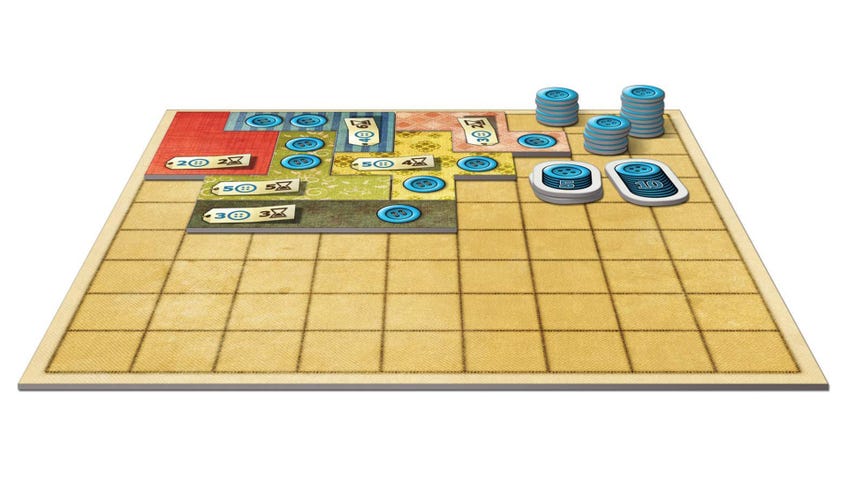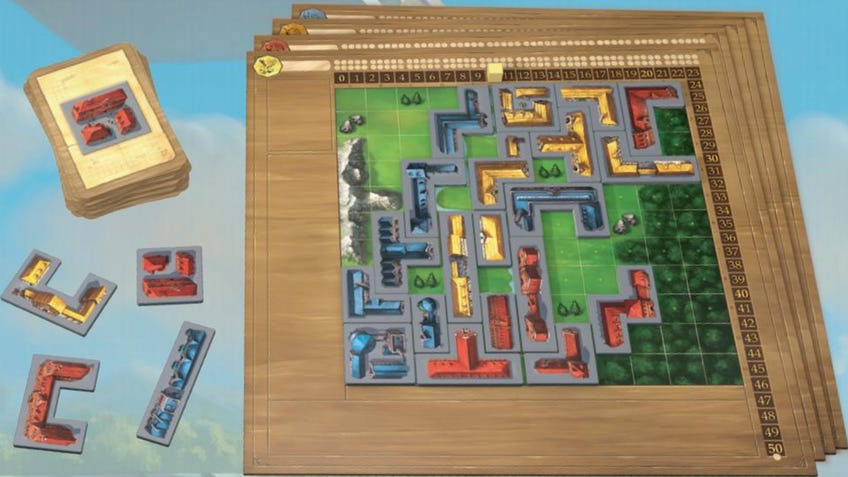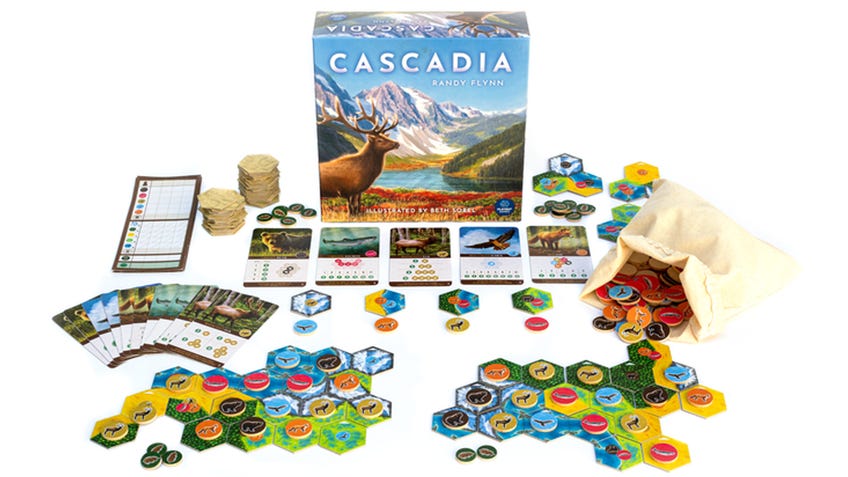10 best tile-placement board games
Pleasing patterns.
Whether you are connecting pathways, train tracks, or buildings, there are few things more satisfying in a board game than placing tiles. If you share a similar attitude towards placing coloured squares into pleasing patterns, you’re sure to find something to love in this list of excellent games that will fulfill that very fantasy.
There are a plethora of games that include this gameplay mechanic, but here we will focus on games where tile-placement is at the core. They appear in no particular order and your preference will come down to personal taste, but you would be hard-pressed to find better examples of the genre.
Best tile-placement board games
- Patchwork
- My City
- Carpe Diem
- Cascadia
- Isle of Skye: From Chieftain to King
- Suburbia
- Traintopia
- Glen More II: Chronicles
- Quadropolis
- Between Two Cities
1. Patchwork
The weather is getting cold and it’s time to cozy up. What better way than with a homemade quilt?

There’s any number of games from the great Uwe Rosenburg that could be included on this list, but Patchwork is certainly a standout. Patchwork is a two-player board game about making a quilt out of polyomino patch tiles. Each turn you draft a patch tile to place onto your quilt which costs a number of buttons and time. Once both players have run out of time, whoever has collected the most buttons is the winner.
The quaint theme will likely be off-putting to some and delightful to others. However, with a simple ruleset, a quick playtime and a unique time management puzzle, Patchwork ticks all the boxes for a great tile-placement game.
Buy Patchwork on Amazon UK and Amazon US
2. My City
It’s time to settle down and build a city in this legacy game of points and progress

Legacy board games are a growing genre and are usually associated with minis, components, envelopes, books, stickers and apps. My City is a breath of fresh air in a stifling cloud of these massive games and is also a box full of envelopes and stickers to discover as you go along, but there is a simplicity to the rules and the campaign that evolves the gameplay in fascinating ways that we wouldn’t dare spoil.
In My City, each player starts with the same set of different colored building tiles in various shapes and sizes. There is a deck of cards that corresponds with these buildings. Each turn, you flip a card and place the building shown according to some basic tile-placement rules. These placement rules, as well as the buildings available and the way you score points, evolve. The campaign is broken up into eight chapters which each have three episodes. Each chapter and episode often introduces new rules or components that incrementally change the game.
These incremental changes keep the gameplay surprising and interesting without changing too much too fast. Still, by the time you reach the end of the campaign, despite the very basic rules staying the same, you feel like you’re playing a different game.
The other great thing about My City is that there is also an “eternal” version of the game that can be played even after the campaign ends. This version doesn’t have the excitement of discovery present in the legacy version, but it’s nice to still be able to play even after your stickers are depleted.
Buy My City on Amazon UK and Amazon US
3. Carpe Diem
Create a prosperous city district as an ancient Roman aristocrat

Carpe Diem is far from the prettiest game in the world, even in its most recent edition that attempted to fix its aesthetic problems. The theme is also uninspiring and a bit disconnected. All that being said, you can’t judge a game solely on how pretty it is, and Carpe Diem is a fantastic game.
In terms of tile-placement, there isn’t much innovation in Carpe Diem. However, the scoring system in Carpe Diem is novel and clever, and the tile-drafting is engaging from beginning to end. The game takes place over four rounds, each having a drafting phase and a scoring phase. In the drafting phase, you will take turns drafting tiles from different depots. You must move to an adjacent depot each turn, so your options are limited and dwindle as the phase progresses.
For scoring, a grid of cards is set up and at the end of each round you select a space where two cards intersect and score those two cards. They may require that you have certain resources or certain buildings and might reward you with points, gold or bread. Once an intersection of cards is claimed by a player, that scoring opportunity is taken up for the rest of the game and can’t be used again. In this way, earning the first position in turn order can be incredibly important so you don’t lose the scoring opportunity that you’ve spent the whole round preparing for.
All of these systems work brilliantly in tandem and make every tile you draft important. There’s a wonderful balancing act between these systems and you can’t ignore any of them. This game is a bit meaner and more difficult than others on the list, but if you’re up for the challenge it’s a blast.
Buy Carpe Diem on Amazon UK and Amazon US
4. Cascadia
Create a harmonious ecosystem in this layered tile puzzle game

In Cascadia, you are responsible for creating hospitable habitats for bears, elk, salmon, hawks and foxes. Each animal scores differently, and Cascadia comes with several scoring cards for every animal for variable setup and scoring each time.
During setup, you will lay out pairs of habitat tiles and wildlife tokens. On your turn, you choose a pair and place them into your environment. Each habitat tile depicts one or more terrain types and wildlife that it can accommodate. You are not required to match like terrain types, but the wildlife you take must be placed on a tile that can accommodate it. There are ways to mitigate your limited options, but most of the time you are forced to work with the options available.
The best part of this game is the fact that you are working out two puzzles at once. At the end of the game you score for the way your wildlife tokens are laid out, and for your largest contiguous group for each terrain type. It’s very easy to focus too much attention on one or the other puzzle, but attention on both is crucial for a good score. Cascadia is a tight, satisfying and approachable tile-placement game that I would recommend to almost anyone.
Buy Cascadia on Zatu UK
5. Isle of Skye: From Chieftain to King
Become the proud leader of a Celtic kingdom

In Isle of Skye you take the role of a chieftain responsible for building up your kingdom in the titular Isle of Skye through a blend of a unique auction/bidding gameplay mechanism, variable scoring and tile-placement.
During setup, you will place four separate scoring tiles depicting the scoring parameters for that game which may include having tiles in certain configurations, tiles with certain symbols on them, or having particular terrain types and sizes. Over the course of six rounds, you will score each tile three times so you must make sure that your kingdom layout and your timing are on point.
The outstanding element of Isle of Skye is how you acquire your tiles. Each round, you will draw three tiles and secretly set a price for two of them. Then, you go around the table and each player has an opportunity to purchase one tile from one other player, paying the price set by that player. You have to purchase any tiles left in front of you after this takes place according to the price you set for it. This creates a fascinating interaction between players as the scoring tiles dictate which tiles are potentially valuable, but it’s up to the players to decide exactly how valuable they are. Price it too high and you risk losing money on a tile you don’t need, too low and you lose out on gouging your opponents on a tile they desperately need.
Buy Isle of Skye: From Chieftain to King from Amazon UK and Amazon US
6. Suburbia
Construct a flourishing community by balancing your population, reputation and income
![Suburbia layout image]](https://assetsio.gnwcdn.com/suburbia-layout-image.jpg?width=848&quality=80&format=jpg&auto=webp)
Suburbia tasks you with taking a small town and developing it into a successful metropolis by balancing several tracks representing the growth and wealth of your population.
Each turn in Suburbia involves you purchasing a tile from the available market and placing it into your city. This will trigger both the tile you’ve just purchased and every tile that it’s touching when you place it. Usually, the effects of tiles will either increase or decrease your population, reputation or income. Your income determines the amount of money you get at the end of your turn, which you will then use to purchase tiles in future turns. Your reputation determines how much your population grows and your population is what determines your score at the end of the game.
What makes the balance tricky is that, typically, a tile that increases one thing can potentially decrease another. Additionally, there are points along the population track that force you to decrease both your reputation and income, so if you shoot too far up the tracks, you may have a tough time digging yourself out of the hole.
Buy Suburbia from Amazon UK and Amazon US
7. Traintopia
What’s more exciting than building efficient transportation infrastructure?

Traintopia is fairly standard tile-placement fare, but with one simple change to the usual formula that proves to have more of an effect than you would expect.
In each round of Traintopia, several tiles and objects are made available as determined by a deck of cards. Players will place tiles to try and create long train tracks with stations at either end in order to score as many points as possible. The various objects, such as meeples, trains and mailboxes, are placed on the tracks throughout the game for immediate scoring and some end-game bonuses.
The minor change that makes the tile-placement in Traintopia particularly interesting is the way the tracks are laid out on the tiles that allow them to be placed without being perfectly aligned. This minor change to the puzzle of laying tiles combined with the usual tension of drafting makes for a satisfying experience.
Buy Traintopia from Amazon UK and Amazon US
8. Glen More II: Chronicles
Expand your clan through trade and construction

Glen More II is a tile-placement game with a rondel-style tile-drafting gameplay mechanism. That means that tiles are laid out on a circular track, and whoever is furthest back on the track gets to take their turn by moving as far forward along the track as they like and taking the tile on that space. However, you can only move in one direction on the track, and you don’t want to move too far ahead and allow other players to potentially take multiple turns in a row.
When placing a tile you must first pay its cost in resources and then follow several placement rules. Similar to Suburbia, you will then activate the effect of the tile you placed and any tiles it’s adjacent to, which will give you resources, points, or other rewards. You can also buy or sell resources at any time on your turn through a dynamic shared market that tracks supply and demand.
This sequel to Glen More also includes a series of chronicles, which are modular expansions to add a variety of challenges. There are several scoring opportunities throughout the game, but during actual scoring rounds you will earn points by possessing more of certain things than your opponents. The further ahead you are in relation to the player furthest behind, the more points you earn.
Buy Glen More II: Chronicles from Amazon UK and Amazon US
9. Quadropolis
Another game about building a city?

In Quadropolis, you will draft several different building types into your city grid that each score differently based on how they are laid out. The rules that determine what tiles you can take and where you can place them are what make this game tense and interesting.
The tiles are laid out in a grid each round, with each player having architects numbered one to four. On your turn, you take one of your architects and place it at the edge of the board pointing at a particular row or column in the grid. The number on the architect you’ve chosen determines which tile you take from that row or column and which row or column you are allowed to place it in on your city grid.
There’s some great brain-burning that takes place as you try to puzzle out exactly how you are going to get precisely the tile you need and place it where you want it to go. There will inevitably be compromise and disappointment, but that doesn’t make the game less fun!
Buy Quadropolis from Zatu UK and Amazon US
10. Between Two Cities
Build something great by working together...sort of

Between Two Cities is yet another city-building game, but this one has a semi-cooperative element. You will be developing two cities simultaneously, working with the players on both sides.
The placement rules and scoring in Between Two Cities feel very familiar to many other tile-placement games, including several on this list. There are several building types, and each one will score points based on how many you have in your city and where they’re placed in relation to other types of buildings. However, at the end of the game, you only score with your least valuable city. This keeps you from concentrating solely on one of your cities so all players are working together, but still trying to outdo each other in a way that feels both tense and friendly.
Buy Between Two Cities on Amazon UK and the Stonemaier Games store



